
The trading floor of the New York Stock Exchange just after the crash of 1929. On Black Tuesday, October twenty-ninth, the market collapsed. In a single day, sixteen million shares were traded--a record--and thirty billion dollars vanished into thin air. Westinghouse lost two thirds of its September value. DuPont dropped seventy points. The "Era of Get Rich Quick" was over. Jack Dempsey, America's first millionaire athlete, lost $3 million. Cynical New York hotel clerks asked incoming guests, "You want a room for sleeping or jumping?" Source
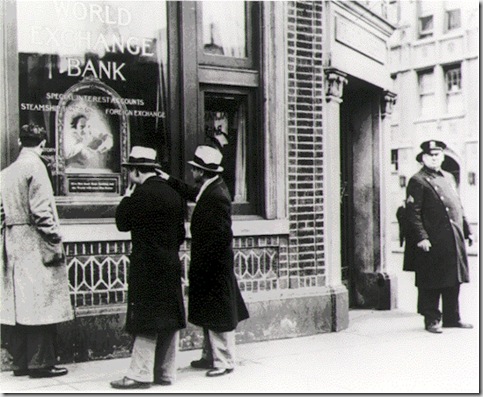
Police stand guard outside the entrance to New York's closed World Exchange Bank, March 20, 1931. Not only did bank failures wipe out people's savings, they also undermined the ideology of thrift. Source
 Unemployed men vying for jobs at the American Legion Employment Bureau in Los Angeles during the Great Depression.
Unemployed men vying for jobs at the American Legion Employment Bureau in Los Angeles during the Great Depression. 
World War I veterans block the steps of the Capital during the Bonus March, July 5, 1932 (Underwood and Underwood). In the summer of 1932, in the midst of the Great Depression, World War I veterans seeking early payment of a bonus scheduled for 1945 assembled in Washington to pressure Congress and the White House. Hoover resisted the demand for an early bonus. Veterans benefits took up 25% of the 1932 federal budget. Even so, as the Bonus Expeditionary Force swelled to 60,000 men, the president secretly ordered that its members be given tents, cots, army rations and medical care.
In July, the Senate rejected the bonus 62 to 18. Most of the protesters went home, aided by Hoover's offer of free passage on the rails. Ten thousand remained behind, among them a hard core of Communists and other organizers. On the morning of July 28, forty protesters tried to reclaim an evacuated building in downtown Washington scheduled for demolition. The city's police chief, Pellham Glassford, sympathetic to the marchers, was knocked down by a brick. Glassford's assistant suffered a fractured skull. When rushed by a crowd, two other policemen opened fire. Two of the marchers were killed. Source

Philipinos cutting lettuce, Salinas, California, 1935. Photographer: Dorothea Lange.
In order to maximize their ability to exploit farm workers, California employers recruited from China, Japan, the Philippines, Puerto Rico, Mexico, the American south, and Europe. Source
The drought that helped cripple agriculture in the Great Depression was the worst in the climatological history of the country. By 1934 it had dessicated the Great Plains, from North Dakota to Texas, from the Mississippi River Valley to the Rockies. Vast dust storms swept the region. Source

Migrant pea pickers camp in the rain. California, February, 1936. Photographer: Dorothea Lange. Source

In one of the largest pea camps in California. February, 1936. Photographer: Dorothea Lange. Source

The photograph that has become known as "Migrant Mother" is one of a series of photographs that Dorothea Lange made in February or March of 1936 in Nipomo, California. Lange was concluding a month's trip photographing migratory farm labor around the state for what was then the Resettlement Administration. In 1960, Lange gave this account of the experience:
I saw and approached the hungry and desperate mother, as if drawn by a magnet. I do not remember how I explained my presence or my camera to her, but I do remember she asked me no questions. I made five exposures, working closer and closer from the same direction. I did not ask her name or her history. She told me her age, that she was thirty-two. She said that they had been living on frozen vegetables from the surrounding fields, and birds that the children killed. She had just sold the tires from her car to buy food. There she sat in that lean- to tent with her children huddled around her, and seemed to know that my pictures might help her, and so she helped me. There was a sort of equality about it. (From: Popular Photography, Feb. 1960).Source

Dorothea Lange's "Migrant Mother," destitute in a pea picker's camp, because of the failure of the early pea crop. These people had just sold their tent in order to buy food. Most of the 2,500 people in this camp were destitute. By the end of the decade there were still 4 million migrants on the road. Source

Freight car converted into house in "Little Oklahoma," California. February, 1936. Photographer: Dorothea LangeSource

Gellert, Hugo, 1924. Vote Communist poster. During the 1920s the American Communist Party was often a victim at once of government oppression and of its own sectarian struggles, but in the mid-1930s it adopted a "popular front" policy of alliances with liberal organizations. Its membership tripled, but more important still were the thousands of sympathizers who endorsed party-supported causes. Source

Demonstration of unemployed, Columbus, Kansas. May 1936. Photographer: Arthur Rothstein. Source

A sharecropper's yard, Hale County, Alabama, Summer 1936. Photographer: Walker Evans Source
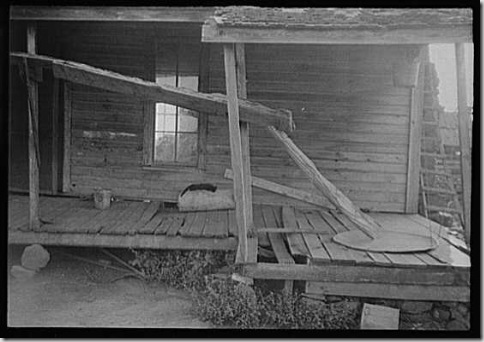
Porch of a sharecropper's cabin, Hale County, Alabama, Summer 1936. Photographer: Walker Evans. The marginal and oppresive economy of sharecropping largely collapsed during the great Depression. Source

Kitchen in house of Floyd Burroughs, sharecropper, near Moundville, Hale County, Alabama. Summer 1936. Photographer: Walker Evans. Source

Part of an impoverished family of nine on a New Mexico highway. Depression refugees from Iowa. Left Iowa in 1932 because of father's ill health. Father an auto mechanic laborer, painter by trade, tubercular. Family has been on relief in Arizona but refused entry on relief roles in Iowa to which state they wish to return. Nine children including a sick four-month-old baby. No money at all. About to sell their belongings and trailer for money to buy food. "We don't want to go where we'll be a nuisance to anybody." Children of migrant workers typically had no way to attend school. By the end of 1930 some 3 million children had abandoned school. Thousands of schools had closed or were operating on reduced hours. At least 200,000 children took to the roads on their own. Summer 1936. Photographer: Dorothea Lange. Source

People living in miserable poverty, Elm Grove, Oklahoma County, Oklahoma. August 1936. Photographer: Dorothea Lange. Source
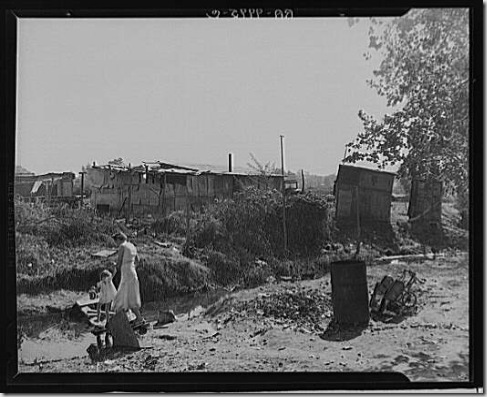
Squatter camp, California, November 1936. Photographer: Dorothea Lange. Source

During the Great Depression, unemployment was high. Many employers tried to get as much work as possible from their employees for the lowest possible wage. Workers were upset with the speedup of assembly lines, working conditions and the lack of job security. Seeking strength in unity, they formed unions. Automobile workers organized the U.A.W. (United Automobile Workers of America) in 1935. General Motors would not recognize the U.A.W. as the workers' bargaining representative. Hearing rumors that G.M. was moving work to factories where the union was not as strong, workers in Flint began a sit-down strike on December 30, 1936. The sit-down was an effective way to strike. When workers walked off the job and picketed a plant, management could bring in new workers to break the strike. If the workers stayed in the plant, management could not replace them with other workers. This photograph shows the broken windows at General Motors' Flint Fisher Body Plant during the Flint sit-down strike of 1936-37. Source
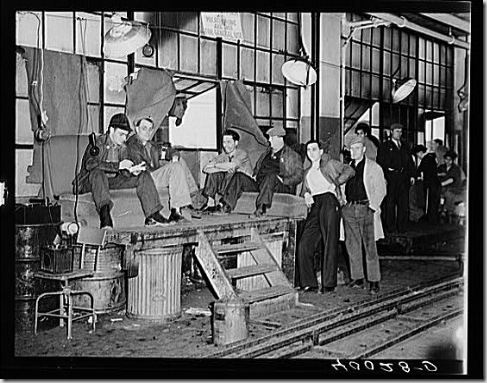
Strikers guarding window entrance to Fisher body plant number three. Flint, Michigan, Jan.-Feb. 1936. Photographer: Sheldon Dick. Source

Toward Los Angeles, California. 1937. Photographer: Dorothea Lange. Perhaps 2.5 million people abandoned their homes in the South and the Great Plains during the Great Depression and went on the road. Source

Waiting for the semimonthly relief checks at Calipatria, Imperial Valley, California. Typical story: fifteen years ago they owned farms in Oklahoma. Lost them through foreclosure when cotton prices fell after the war. Became tenants and sharecroppers. With the drought and dust they came West, 1934-1937. Never before left the county where they were born. Now although in California over a year they haven't been continuously resident in any single county long enough to become a legal resident. Reason: migratory agricultural laborers. March 1937. Photographer: Dorothea Lange. Source

Drought refugees near Holtville, California. March 1937. Photographer: Dorothea Lange Source
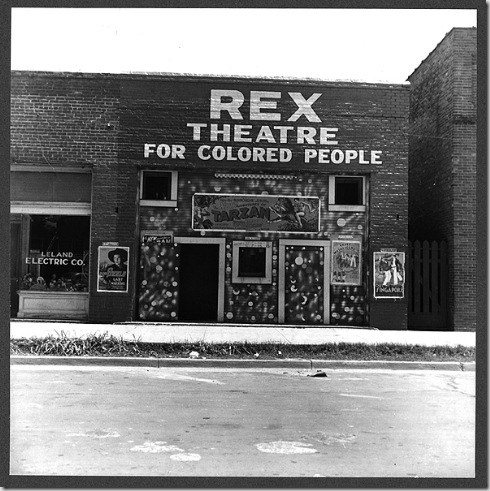
Leland, Mississippi, in the Delta area, June 1937. Photographer: Dorothea lange. Source

Lincoln Brigade Ambulance Corps. Group photo in New York of sixteen volunteers, American Medical Bureau. 125 American men and women served in the Spanish Civil War with the American Medical Bureau as nurses, doctors, and support staff. 1936-1939. The Spanish Civil War was the great international cause of the 1930s. Aided by Hitler and Mussolini, the Spansih military led a revolt against the progressive elected government. About 3,000 Americans volunteered to fight on behlaf of the Spanish Republic. Click here for the MAPS page on the Spanish Civil War Source

Spanish Civil War demonstration in New York. Press photo. Photograph by "Alexander, 177 Thompson Street, New York."Source
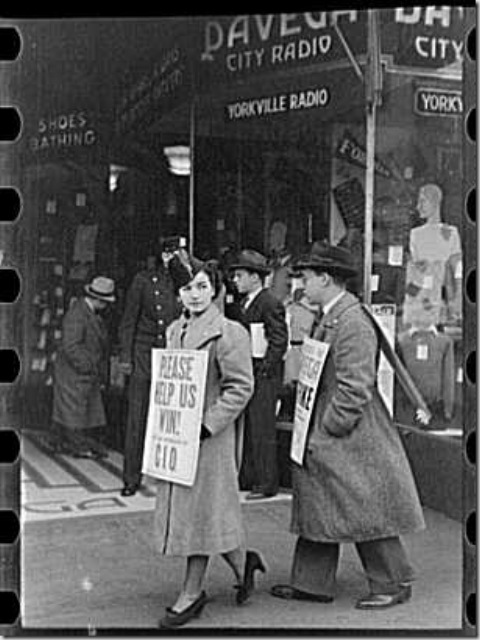
Strike pickets, New York, New York. Dec. 1937. Photographer: Arthur Rothstein. Source

Unemployed workers in front of a shack with Christmas tree, East 12th Street, New York City. December 1937. Photographer: Russell Lee. Tattered communities of the homeless coalesced in and around every major city in the country. Source

Part of the daily lineup outside the State Employment Service Office. Memphis, Tennessee. June 1938. Photographer: Dorothea Lange. Source

Squatter makes coffee in kitchen at his home in abandoned warehouse, Caruthersville, Missouri. August 1938. Photographer: Russell Lee. Source

Members of the picket line at King Farm strike. Morrisville, Pennsylvania. August 1938. Photographer: John Vachon. In contrast to a frequently racist society, several unions were militantly integrationist. Source

Power farming displaces tenants. Texas panhandle, 1938. Photographer: Dorothea Lange. Source

Squatters in Mexican section in San Antonio, Texas. House was built of scrap material in vacant lot in Mexican section of San Antonio, Texas. March 1939. Photographer: Russell Lee. Source

Mexican woman arranging things in her shack home. San Antonio, Texas. March 1939. Photographer: Russell Lee. Source
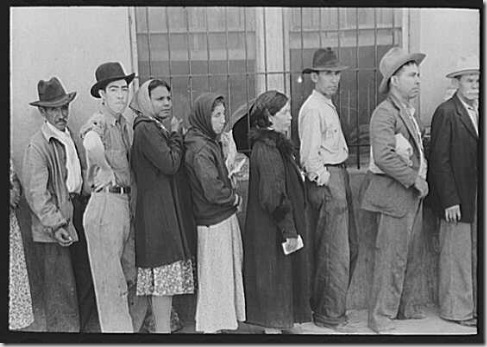
Relief line waiting for commodities, San Antonio, Texas. March 1939. Photographer: Russell Lee. Source
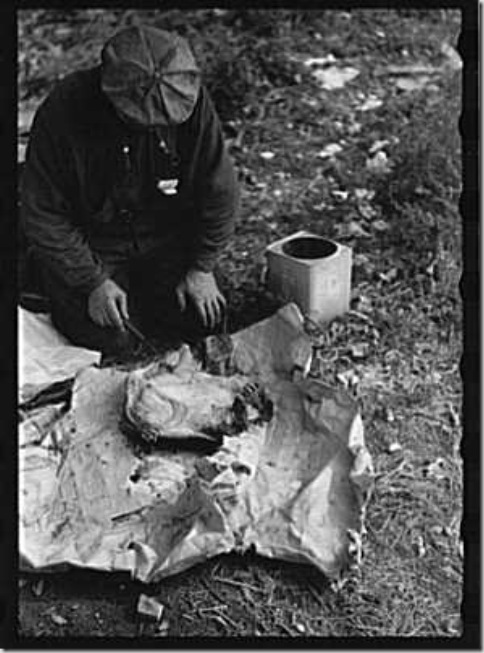
Man in hobo jungle killing turtle to make soup, Minneapolis, Minnesota. Sept. 1939. Photographer: John Vachon. Source

Selling apples, Jacksonville, Texas. October, 1939. Photographer: Russell Lee. Many tried apple-selling to avoid the shame of panhandling. In New York City, there were over 5,000 apple sellers on the street. Source

Young boys waiting in kitchen of city mission for soup which is given out nightly. Dubuque, Iowa. April 1940. Photographer: John Vachon. For millions, soup kitchens offered the only food they would eat. Source

Durham, North Carolina, May 1940. Photographer: Jack Delano. "At the bus station." Source

Upstairs bedroom of family on relief, Chicago, Illinois. April 1941. Photographer: Russell Lee. Source

Yabucoa, Puerto Rico. Strikers near the sugar mill. Jan. 1942. Photographer: Jack Delano. Source

Yabucoa, Puerto Rico. In the mill village at the sugar mill. Jan. 1942. Photographer: Jack Delano. Source
Fonte





Grazie tantissimo per queste foto! Mi hanno aiutato tanto con il mio proggetto per storia, avete, piu' foto di tanti altri siti, e non sono sempre le stesse. Ancora, grazie!
RispondiElimina